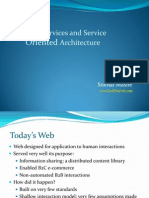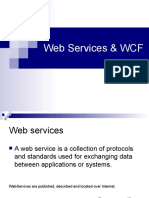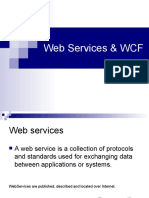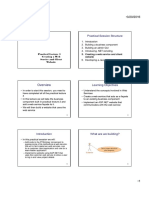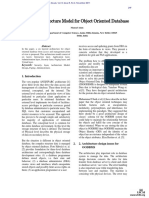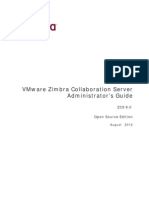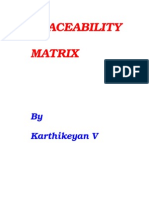2524 Developing XML Web Services Using MS Visual C Sharp
Uploaded by
Satya Surendra2524 Developing XML Web Services Using MS Visual C Sharp
Uploaded by
Satya SurendraExecuTrain Course Outline Developing XML Web Services Using Microsoft Visual c# .
Net
MOC 2524
3 Days
Description
The goal of this course is to provide students with the knowledge and skills required to develop Web Services based solutions to solve common problems in the distributed application domain. The course focuses on using the Microsoft Visual Studio .NET, Microsoft Visual C# .NET, Microsoft ASP.NET, and Universal Description, Discovery, and Integration (UDDI) to enable students to build, deploy, locate, and consume Web Services. This course is intended for experienced software developers who have previously built component-based applications.
Prerequisites
Before attending this course, students must have:
An understanding of how to read and write Extensible Markup Language (XML) documents.
Experimented with simple C# applications. Developed distributed applications using Microsoft Visual Basic, Java, or C++.
Performance-based Objectives
After completing the course, students will be able to:
Explain how Web Services emerged as a solution to the problems with traditional approaches to designing distributed applications.
Describe the architecture of a Web Services-based solution.
Describe the underlying technologies of Web Services and explain how the Microsoft .NET Framework can be used to implement Web Services using these technologies.
Implement a Web Service consumer by using Microsoft Visual Studio .NET Beta 2.
Page 1 of 2
#MOC2524 Rev. August, 12
Implement a simple Web Service by using Visual Studio .NET Beta 2. Publish and deploy a Web Service. Secure a Web Service.
Evaluate the trade-offs and issues involved in designing a real-world Web Service. Implement nonstandard Web Services such as HyperText Markup Language (HTML) screen scraping and aggregating Web Services.
Microsoft Certified Professional Exams
This course will help the student prepare for the following Microsoft Certified Professional exam:
There is no MCP exam associated with this course.
Course Materials
The student kit includes a comprehensive workbook and other necessary materials for this class. The following software is provided for use in the classroom:
Microsoft Visual Studio .NET Beta 2 Microsoft Windows Component Update of the Beta 2 compact disc set Microsoft UDDI SDK version 1.52
Outline
Module 1: The Need for Web Services
The following topics are covered in this module:
Evolution of Distributed Applications Problems with Traditional Distributed Applications Introducing Web Services The Web Technology Stack and .NET The .NET Alternatives to Web Services Common Web Service Scenarios
After completing this module, you will be able to explain how Web Services emerged as a solution to the problems with traditional approaches to designing distributed applications. This includes:
Describing the evolution of distributed applications.
Identifying the problems with traditional distributed application architectures and technologies.
Page 2 of 2
#MOC2524 Rev. August, 12
Describing Web Services and briefly explaining how they address the design problems in traditional distributed applications.
Listing the alternate options for distributed application development.
Identifying the kinds of scenarios where Web Services are an appropriate solution. Module 2: Web Service Architectures
The following topics are covered in this module:
Service-Oriented Architecture Web Service Architectures and Service-Oriented Architecture Roles in a Web Service Architecture The Web Services Programming Model
After completing this module, you will be able to describe the architecture of a Web Services-based solution. This includes:
Identifying how Web Service architectures are a type of service-oriented architecture.
Describing the elements of a Web Service architecture and explaining their roles. Describing the Web Service programming model.
Module 3: The Underlying Technologies of Web Services
The following topics are covered in this module:
HTTP Fundamentals XML Essentials SOAP Fundamentals
After completing this module, you will be able to describe the underlying technologies of Web Services and explain how the .NET Framework can be used to implement Web Services using these technologies. This includes:
Describing the structures of a Hypertext Transfer Protocol (HTTP) request and response.
Issuing HTTP POST and GET requests and processing the responses by using the .NET Framework. Describing data types by using the XML Schema Definition language (XSD). Explaining how to control the way a .NET Framework object is serialized to XML.
Describing the structures of a Simple Object Access Protocol (SOAP) request and response. Issuing a SOAP request and processing the response by using the .NET Framework.
Page 3 of 2
#MOC2524 Rev. August, 12
Module 4: Consuming Web Services
The following topics are covered in this module:
WSDL Documents Web Service Discovery Web Service Proxies Implementing a Web Service Consumer Using Visual Studio .NET
After completing this module, you will be able to implement a Web Service consumer by using Visual Studio .NET Beta 2. This includes:
Explaining the structure of a Web Service Description Language (WSDL) document.
Explaining the Web Services Discovery process. Locating service contracts by using Disco.exe. Generating Web Service proxies by using Wsdl.exe. Implementing a Web Service consumer by using Visual Studio .NET.
Invoking a Web Service synchronously and asynchronously by using a Web Service proxy.
Module 5: Implementing a Simple Web Service
The following topics are covered in this module:
Creating a Web Service Project Implementing Web Service Methods Managing State in an ASP.NET Web Service Debugging Web Services
After completing this module, you will be able to implement a simple Web Service by using Visual Studio .NET Beta 2. This includes:
Creating a Web Service project.
Implementing Web Service methods, exposing them, and controlling their behavior. Managing state in an ASP.NET-based Web Service. Debugging Web Services.
Module 6: Publishing and Deploying Web Services
The following topics are covered in this module:
Overview of UDDI
Page 4 of 2
#MOC2524 Rev. August, 12
Publishing a Web Service Finding a Web Service Publishing a Web Service on an Intranet Configuring a Web Service
After completing this module, you will be able to publish and deploy a Web Service. This includes:
Explaining the role of UDDI in Web Services. Publishing a Web Service in a UDDI registry using the UDDI SDK. Searching a UDDI registry to locate Web Services by using the UDDI SDK. Explaining the various options for publishing a Web Service on an intranet.
Explaining some of the options for modifying the default configuration of a Web Service.
Module 7: Securing Web Services
The following topics are covered in this module:
Overview of Security Built-In Authentication Custom Authentication: SOAP Headers Authorization: Role-Based Security Authorization: Code Access Security Encryption
After completing this module, you will be able to secure a Web Service. This includes:
Identifying the differences between authentication and authorization.
Explaining how to use the security mechanisms provided by Microsoft Internet Information Services (IIS) and Windows for authentication. Using SOAP headers for authentication in a Web Service.
Using role-based security and code access security for authorization in a Web Service. Encrypting the communication between a Web Service consumer and a Web Service.
Module 8: Designing Web Services
The following topics are covered in this module:
Datatype Constraints
Page 5 of 2
#MOC2524 Rev. August, 12
Scalability Performance Reliability Versioning ISP and ASP Deployment Architectural Elements
After completing this module, you will be able to evaluate the trade-offs and issues involved in designing a real-world Web Service. This includes:
Identifying the restrictions imposed on datatypes by the various Web Services protocols.
Explaining how the use of Application and Session state can affect the performance and scaling of Web Services. Explaining how output and data caching can be used to improve Web Service performance. Explaining the need for instrumenting Web Services. Identifying the components of a Web Service that can be versioned.
Explaining how deploying a Web Service at an Internet Service Provider (ISP) or an Application Service Provider (ASP) can affect the design of the Web Service. Explaining the limitations in using two-phase commit transactions and eventing in Web Services.
Module 9: : Implementing a Nonstandard Web Service
The following topics are covered in this module:
HTML Screen Scraping Web Services Aggregating Web Services
After completing this module, you will be able to implement nonstandard Web Services such as HTML screen scraping and aggregating Web Services. This includes:
Explaining how to implement a HTML screen scraping Web Service. Identifying the scenarios where aggregated Web Services are appropriate.
Implementing an aggregating Web Service that uses multiple Web Services.
Page 6 of 2
#MOC2524 Rev. August, 12
You might also like
- Ultimate SnowPro Core Certification Course Slides by Tom BaileyNo ratings yetUltimate SnowPro Core Certification Course Slides by Tom Bailey333 pages
- MOC 20487B: Developing Windows Azure and Web Services Course OverviewNo ratings yetMOC 20487B: Developing Windows Azure and Web Services Course Overview9 pages
- SharePoint Configuration Guidance For 21 CFR Part 11 ComplianceNo ratings yetSharePoint Configuration Guidance For 21 CFR Part 11 Compliance78 pages
- 2524 Developing XML Web Services Using: NHM2524A-ILTNo ratings yet2524 Developing XML Web Services Using: NHM2524A-ILT1 page
- Web ServicesWeb Services and Service Oriented ArchitectureNo ratings yetWeb ServicesWeb Services and Service Oriented Architecture54 pages
- Developing Windows Azure and Web ServicesNo ratings yetDeveloping Windows Azure and Web Services4 pages
- Unit-4 - ASP - Net and Web Development - Part-4No ratings yetUnit-4 - ASP - Net and Web Development - Part-427 pages
- Session 2 Evolution Web Service and Primitive SOANo ratings yetSession 2 Evolution Web Service and Primitive SOA25 pages
- Distributed Computing - Lab Report: - :By:-Ms Poonam Singh ChandravanshiNo ratings yetDistributed Computing - Lab Report: - :By:-Ms Poonam Singh Chandravanshi58 pages
- Final Semantic Web Unit2 - QuestionsandAnswer BookletNo ratings yetFinal Semantic Web Unit2 - QuestionsandAnswer Booklet17 pages
- Best Practices For Building Web Services With Visual Studio: Sanguan ThammarojsakulNo ratings yetBest Practices For Building Web Services With Visual Studio: Sanguan Thammarojsakul28 pages
- Web Services Overview:: A Technical IntroductionNo ratings yetWeb Services Overview:: A Technical Introduction19 pages
- SynapseIndia Dotnet Development With DemoNo ratings yetSynapseIndia Dotnet Development With Demo10 pages
- Nigel Watson Academic Developer Relations Developer and Platform Strategy Group Microsoft PTY, MelbourneNo ratings yetNigel Watson Academic Developer Relations Developer and Platform Strategy Group Microsoft PTY, Melbourne35 pages
- Chapter 6 - Service-Oriented Architecture (Lecture 8 & 9) - 1No ratings yetChapter 6 - Service-Oriented Architecture (Lecture 8 & 9) - 170 pages
- Real-World Web Development with .NET 9: Build websites and services using mature and proven ASP.NET Core MVC, Web API, and Umbraco CMSFrom EverandReal-World Web Development with .NET 9: Build websites and services using mature and proven ASP.NET Core MVC, Web API, and Umbraco CMSNo ratings yet
- Web Services: Internet and Web Application Development100% (1)Web Services: Internet and Web Application Development17 pages
- Six Layers Architecture Model For Object OrientedNo ratings yetSix Layers Architecture Model For Object Oriented4 pages
- JSF: Introduction JSF: Introduction, Installation, and SetupNo ratings yetJSF: Introduction JSF: Introduction, Installation, and Setup14 pages
- Moving Internal Audit Deeper Into The Digital AgeNo ratings yetMoving Internal Audit Deeper Into The Digital Age20 pages
- SAP Basis For Beginner - How To Configure Single Sign On (SSO) Between SAP GUI (Backend System) and Portal (Front End)No ratings yetSAP Basis For Beginner - How To Configure Single Sign On (SSO) Between SAP GUI (Backend System) and Portal (Front End)33 pages
- Build and Deploy A Microservice With Kubernetes - TechTargetNo ratings yetBuild and Deploy A Microservice With Kubernetes - TechTarget8 pages
- SEWP ZG512 Object Oriented Analysis and Design Prof. Santosh ChobeNo ratings yetSEWP ZG512 Object Oriented Analysis and Design Prof. Santosh Chobe31 pages










